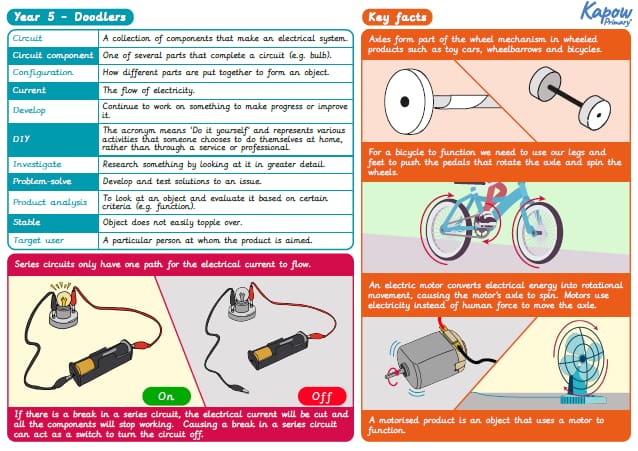Electrical systems: Doodlers
Investigating an existing motorised product and problem-solving to understand its construction before developing their own.
The Curriculum and Assessment Review final report has been released. We’re reviewing the recommendations and planning for future updates. Learn more
- Subjects >
- Design and technology >
- Key stage 2 >
- Year 5 >
- Electrical systems >
-
Electrical systems: Doodlers
Please note
This unit has been replaced by the unit *New* Electrical systems: Wobble bots. It will move to our Content archive in August 2026. It will remain permanently available but will not be updated in line with curriculum or website developments.
Unit outcomes
Pupils who are secure will be able to:
- Identify simple circuit components (battery, bulb and switch) with a basic explanation of their function.
- Explain that a series circuit is assembled in a loop to allow the electricity to flow along one path.
- Describe a motor as a circuit component that changes electrical energy into movement.
- Provide examples of motorised products that use movement to rotate or spin different parts.
- Remove and replace different parts of a Doodler, as part of a team.
- Suggest ways to switch the configuration to amend the form or function of the Doodler.
- Explain, in an investigation report, each of the changes they made and the effect this had on the Doodler’s ability to draw scribbles (function) and appearance (form).
- Develop design criteria with consideration for the target user, the purpose of their Doodler, a key function and the Doodler’s form and final appearance (e.g. fun, bright, soft).
- Explain simply why their Doodler has a certain configuration based on the findings of their investigation (e.g. I used four pens because the Doodler would fall over with two).
- Create a functional Doodler that creates scribbles on paper with or without a switch.
- Identify and list each of the required materials, tools and circuit components required to build a Doodler.
- Explain simply the steps to assemble a Doodler as part of a set of instructions (or storyboard).
- Write instructions to build a functional circuit, explaining how to identify if it is functional or not.
- Provide suggestions to improve a peer’s set of instructions after testing how effective they are at guiding someone.
Suggested prior learning
Electrical systems: Torches
Get startedLessons
Lesson 1: Electrical systems and motors
- To understand how motors are used in electrical products.
Lesson 2: Meet the Doodlers
- To investigate an existing product to determine the factors that affect the product’s form and function.
Lesson 3: Doodler design and construction
- To apply the findings from research to develop a unique product.
Lesson 4: Doodler DIY kits
- To develop a DIY kit for another individual to assemble their product.
Key skills
Key knowledge
Related content
Unit resources

Knowledge organiser – DT: Y5 Electrical systems: Doodlers
Aimed at pupils, a single page which gives key facts and definitions from the unit "Electrical systems: Doodlers".

Vocabulary display – D&T Y5: Electrical systems: Doodlers
A display version of the vocabulary from the unit 'Doodlers'.
Cross-curricular opportunities
Science
‘Pupils should be taught to:
- construct a simple series electrical circuit, identifying and naming its basic parts, including cells, wires, bulbs, switches and buzzers’
See National curriculum - Science key stages 1 to 2.
English
‘Pupils should be taught to:
- evaluate and edit by:
- assessing the effectiveness of their own and others’ writing
- proposing changes to vocabulary, grammar and punctuation to enhance effects and clarify meaning’

